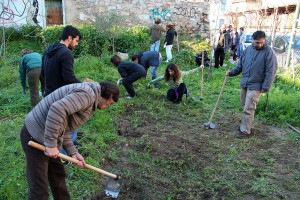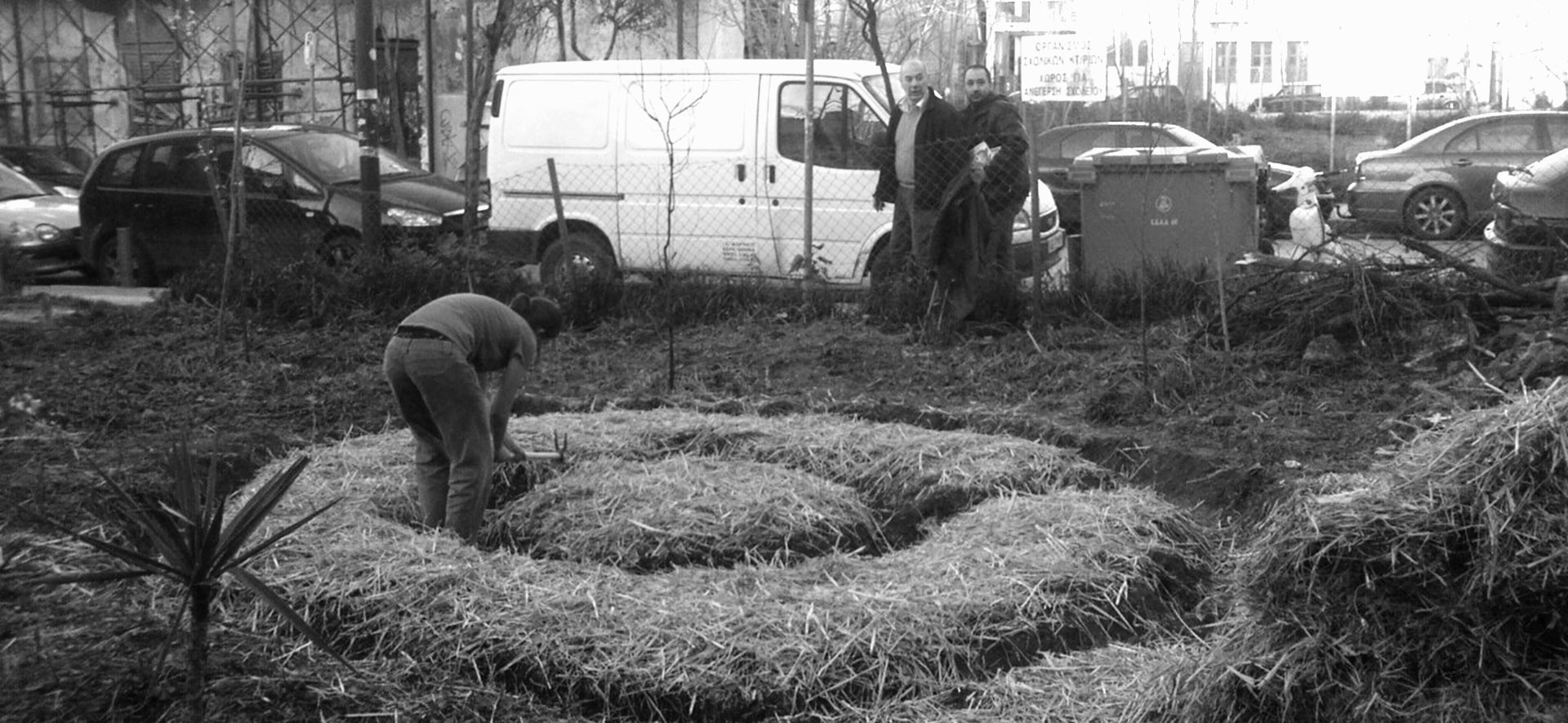Location: empty space on the Agion Asomaton Street -Psirri
A story about the multiple faces of violence and war in the city center.
“We walk in darkness, guided by the light of the utopian star of our projections and driven by the rage of our “No” towards this present inhumanity”
John Holloway

The search for an empty space in the city center to create a self-managed Community Garden was an idea that had begun long ago, with the impact of community gardens that have existed for years in other cities, and after the trip and participation of Nomadic Architecture in an action in jardino Parajiso in Manhattan, at Lower East Side.
Navarino Street Park had a significant influence as well as other struggles for public space in Athens, such as the try of the activists to claim Filopappou hill to remain free, for the Elliniko, for the Cyprus and Patision Park, and for the park in villa Drakopoulou etc.
Communal self-managed gardens in the historic city center are a bet, an important claim and a symbolic gesture of cohabitation of diversities in an area withomnipresence of the police and its residents who were, at that time, homeless people, immigrants hiding to avoid their closure in camps, HIV-infected prostitutes that were jailed, immigrants with carts living by the things they collect and sell from the garbage. The homeless, the young unemployed, the craftsmen who are worried about the very next day are many of the center’s residents.
Communal self-managed gardens in the center of the city could provide another route in the city, against the persecution of the immigrants and the fear that deliberately has spread in the center of Athens.
The first garden in Psiri area, which was created in the empty plot of Asomaton Str., was a symbolic gesture for cohabitation in the city. We wanted it to be a place where the diversities of the city can participate and meet, to cultivate and, through the contact with plants and soil, to change the aggressive often destructive behavior that this city has taught them, to ensure fresh food with their own hands. Already on May 1st we had the first spinach which an immigrant took and cooked it.

After a research we did we found that the available empty plots in the area owned by the government, were only the plots in Asomaton Str. that we learned that belonged to the Ministry of Culture. The plots were abandoned, without fencing, with weeds and a lot of garbage. During the occupation of Embros Theatre on February, after an initiative from the residents of Psirri, two discussions took place concerning the topic “communal gardens in the city.” On the first Saturday of March under the initiative of the residents of Psiri we started the creation of the garden in the plot at Ag. Asomaton Str. Some of the participants were the team dealing with natural farming “New Guinea” and many more others who had been informed about this initiative from the residents and Facebook.
The plot was cleaned of the weeds, the stones became hills, peat pellets with seeds were planted in a circle, covered with straw, seeds were planted in pots, the compost was done. Our desire was to be accessible to everyone and everyone to be able to plant, enjoy fresh food, to help regarding the meet of the needs and communication, while the neighborhood children and more specifically from the neighboring primary school to have the opportunity to learn how to cultivate the land. “The garden would help the city to get into a process of changing, because we have the right to change it.” We continue to work in the garden every Saturday.

On May Day we entered the garden, removing the barbed wire and breaking the lock. We planted, watered, we cut the first spinach, we gave treats to each other and discussed about what was going to happen next. Many passers-by came by the garden as the space was a passage.The next day the fence and the lock were placed again. When we visited the director of the department of the Ministry of Culture, Education and Religious Affairs she told us that she is only interested in ancient ruins and not people nor plants, and that her intervention to the Council would be negative. She told us clearly that her goal was to get over with the garden and all of us.
On next Saturday we visited the garden again and the wooden sign “Garden” that we had made and placed in the soil was not there. In its place there was a sign that was fixed with cement and wrote “Ministry of Culture, Education and Religious Affairs – Inland Revenue of Antiquities “. It was obvious, that a war between us had just begun.
In August the plants we planted were uprooted.

